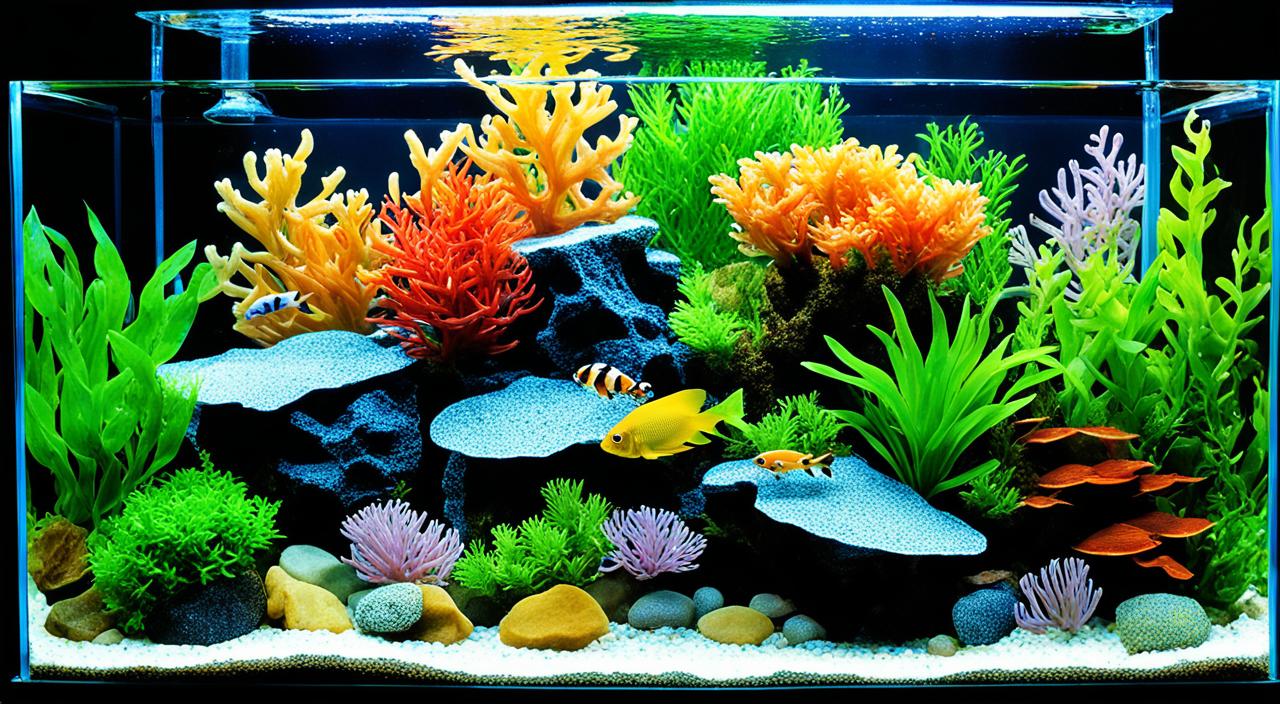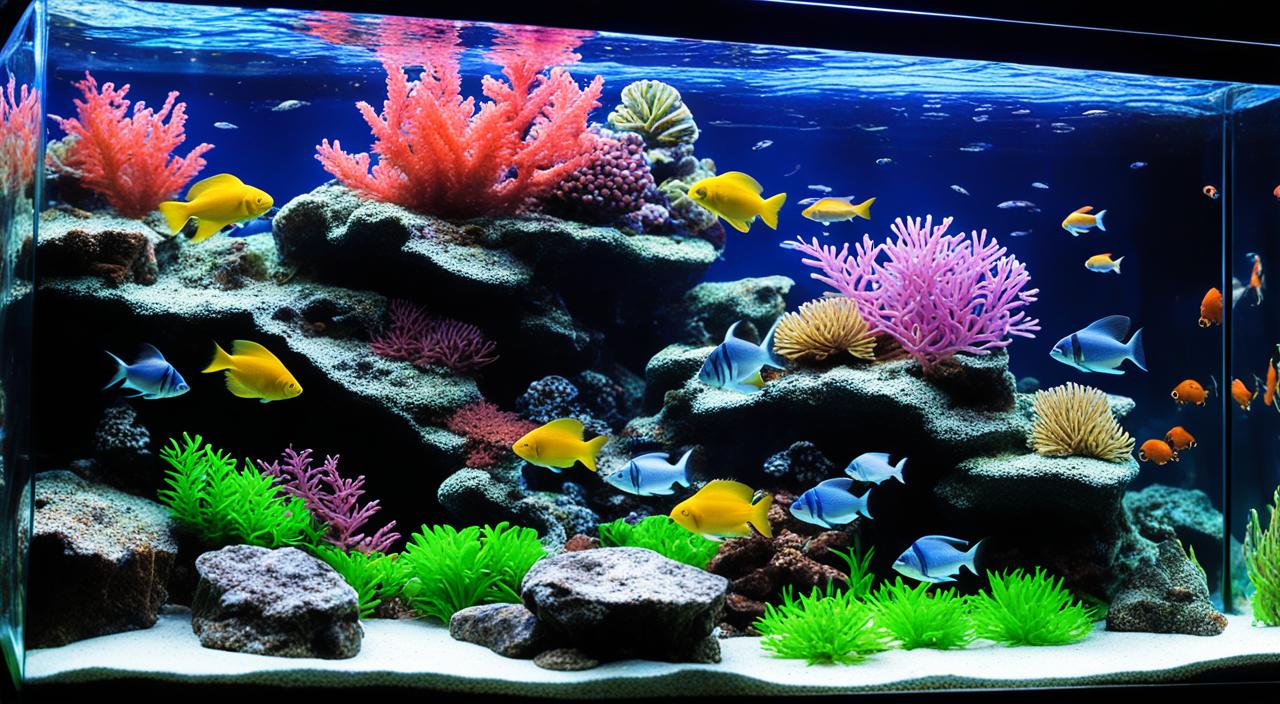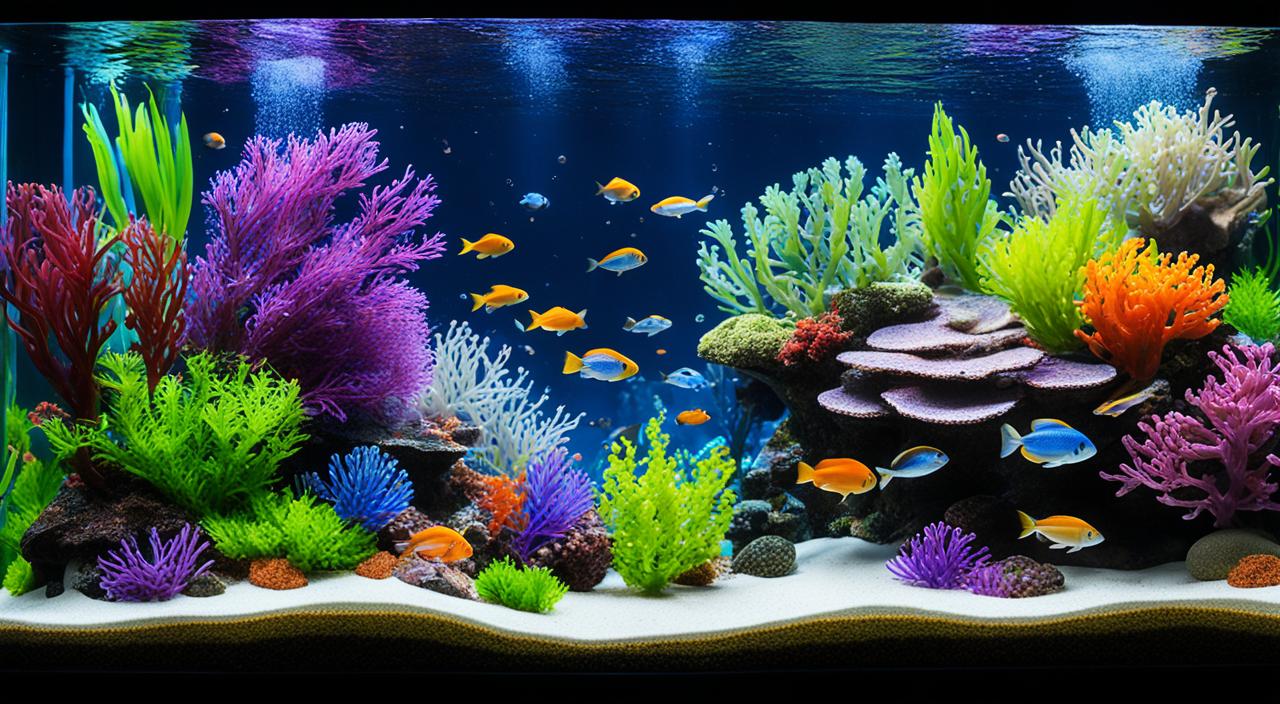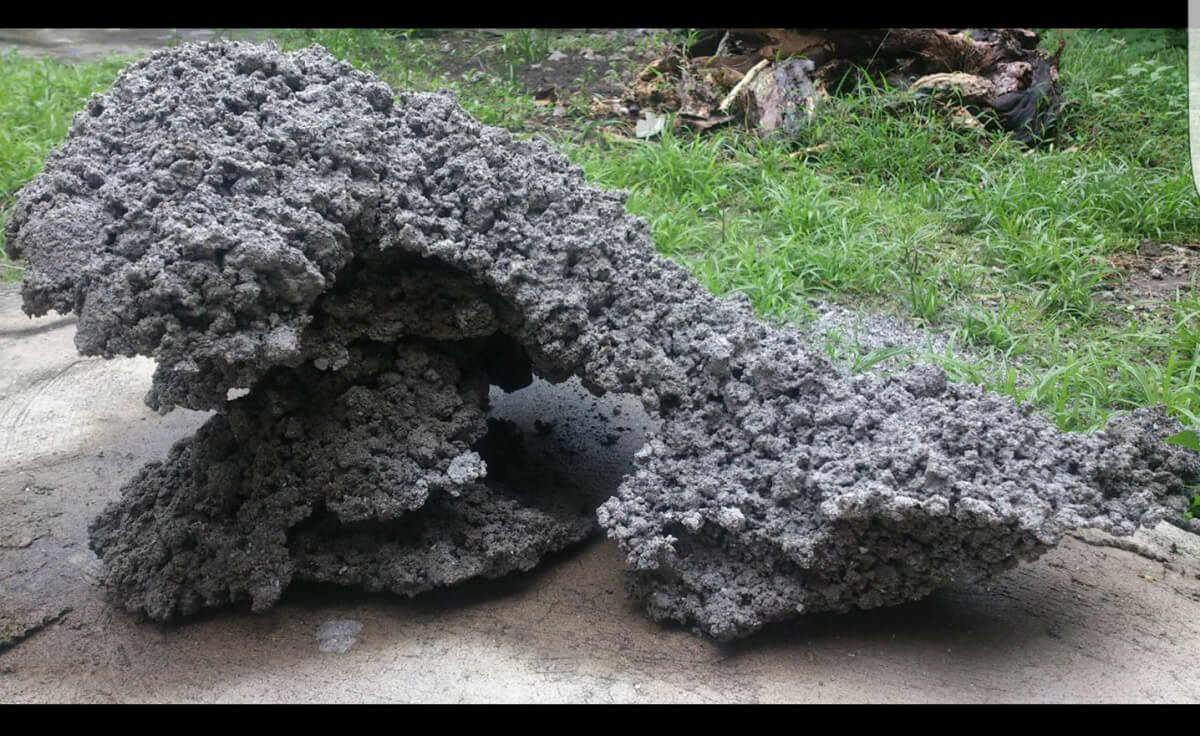Are you overwhelmed by the many choices for your 20 gallon aquarium setup? Do you wonder, “Which tank will meet my fish’s needs and reflect my style and commitment to their well-being?”
Dive into the world of aquariums with us as we explore how to select the perfect 20 gallon tank for your vision and your aquatic friends’ intricate needs.
Key Takeaways:
- Choosing the right 20 gallon tank is essential for meeting your fish’s needs and reflecting your style.
- A 20 gallon tank provides suitable space for various fish and other aquatic creatures.
- Consider factors such as tank type, materials, dimensions, and other important considerations when deciding.
- Understanding your aquatic friends’ needs and preferences will help you create a thriving and visually appealing aquarium setup.
- Explore custom aquarium options if you want a unique and aesthetically pleasing design.
Introduction to Aquarium Keeping
Aquarium keeping is a rewarding hobby, allowing you to create a serene underwater world in your home. Whether you’re a beginner or an experienced enthusiast, choosing the right tank is crucial for the well-being of your aquatic pets. This section will explore why a 20 gallon tank is an optimal choice for beginners and provide valuable tips for sustainable fish keeping.
Why Choose a 20 gallon Tank?
A 20 gallon tank is often recommended as the ideal starting point for beginner aquarists. It offers several advantages that contribute to the overall success of your aquarium:
- Optimal Tank Size: The 20 gallon tank provides enough space to accommodate a variety of fish species. It allows for adequate swimming room and reduces the likelihood of territorial conflicts among your aquatic pets.
- Stable Water Conditions: The larger volume of water in a 20 gallon tank promotes more stable water conditions. This stability helps dilute toxins, maintain a consistent temperature, and support a healthy ecosystem for your fish.
- Easier Maintenance: A 20 gallon tank is easier to maintain than a smaller tank. It allows for better filtration options, improving water quality and reducing maintenance efforts.
- Sustainable Fish Keeping: Opting for a larger tank size, like the 20 gallon tank, promotes sustainable fish-keeping practices. The increased water volume provides a more stable environment, reducing stress on the fish and enabling them to thrive.
Understanding Aquarium Types
When setting up your 20 gallon tank, it’s essential to understand the different types of aquariums available. Each type offers unique characteristics, fish species, and maintenance requirements. The three main types to consider are freshwater tanks, saltwater tanks, and brackish tanks.
Freshwater Tanks
Freshwater tanks are the most common choice for beginners in fishkeeping. They are popular due to the wide variety of fish species that can thrive in freshwater environments. Compared to other types, freshwater tanks are relatively easier to set up and maintain. They offer a cost-effective and sustainable fishkeeping experience, making them ideal for beginners seeking a rewarding hobby.
Saltwater Tanks
Saltwater tanks, also known as marine tanks, require more expertise and attention to detail. These tanks recreate the conditions found in the ocean, allowing you to keep stunning marine fish and coral. Saltwater tanks offer a vibrant and diverse aquatic environment.
Still, they require advanced filtration systems, precise water parameters, and regular maintenance to ensure the health and well-being of marine life. A saltwater tank might be the right choice if you’re ready for a more challenging and visually stunning fishkeeping experience.
Brackish Tanks
Brackish tanks are a unique combination of freshwater and saltwater environments. They provide a specialized habitat for certain fish species that thrive in habitats where freshwater meets saltwater, such as estuaries and mangrove swamps.
Brackish tanks require a careful balance of freshwater and saltwater and specific fish species that adapt well to this unique environment. If you’re interested in keeping fish with a unique habitat preference, a brackish tank can provide an exciting and educational experience.
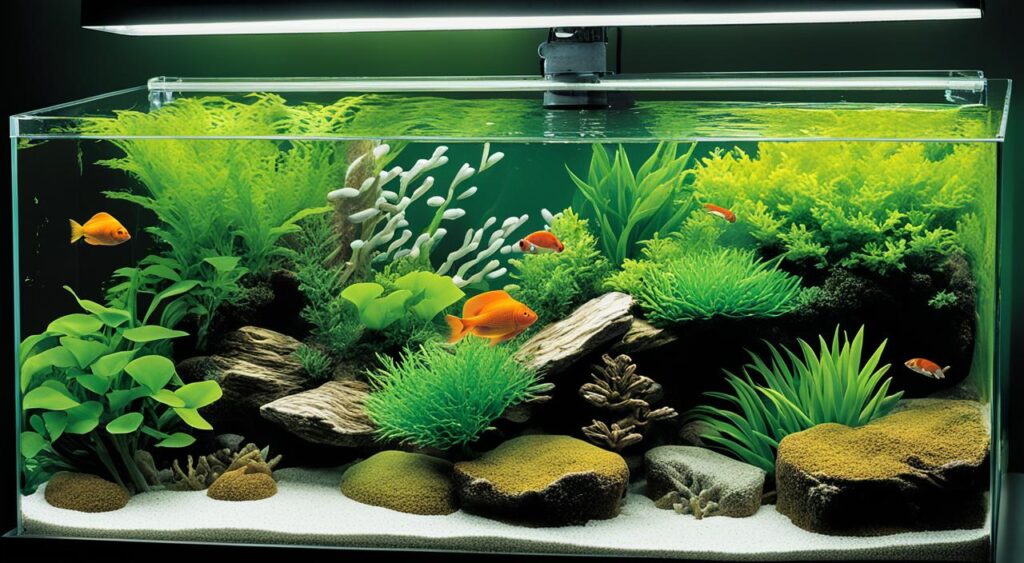
| Type of Tank | Characteristics | Suitable Fish | Maintenance Level |
|---|---|---|---|
| Freshwater Tanks | Easy to set up and maintain, cost-effective | Goldfish, Tetras, Guppies, Bettas | Low to moderate |
| Saltwater Tanks | Visually stunning, vibrant marine life | Clownfish, Tangs, Damsels, Corals | High |
| Brackish Tanks | Combination of freshwater and saltwater | Fiddler Crabs, Bumblebee Gobies, Archerfish | Moderate |
Understanding the differences between freshwater, saltwater, and brackish tanks will help you decide on the type of tank that suits your preferences and skill level. Consider factors such as the fish species you want to keep, maintenance requirements, and the level of expertise you are willing to invest in your aquarium setup.
Choosing the Right Material
Glass Tanks
Glass tanks have long been the preferred choice for aquarium enthusiasts. Offering excellent durability and clarity, they provide a crystal-clear view of your underwater world. They are also less prone to scratching, ensuring that your tank remains visually appealing for years to come. Glass tanks also offer excellent insulation, maintaining a stable temperature for your fish. Their sturdy construction makes them less likely to break, providing a safer environment for your aquatic friends.
However, it’s important to note that glass tanks can be heavier and more fragile than other materials. The weight of a glass tank should be considered, especially if you plan to place it on a delicate support structure. Additionally, handling glass tanks with care during transportation and maintenance is essential to avoid any potential damage.
Acrylic Tanks
Acrylic tanks present a lightweight and impact-resistant alternative to glass. Their lightweight nature makes them easier to move and handle than glass tanks. Acrylic tanks also offer excellent insulation properties, helping to maintain a stable temperature for your fish. The impact-resistant nature of acrylic ensures that your tank is less likely to break or crack, providing added safety for your aquatic inhabitants.
While acrylic tanks offer these benefits, they can be more susceptible to scratching than glass tanks. Care must be taken when cleaning and maintaining an acrylic tank to prevent surface damage. It’s advisable to use specific cleaning tools and avoid abrasive materials to ensure the longevity and clarity of your acrylic tank.
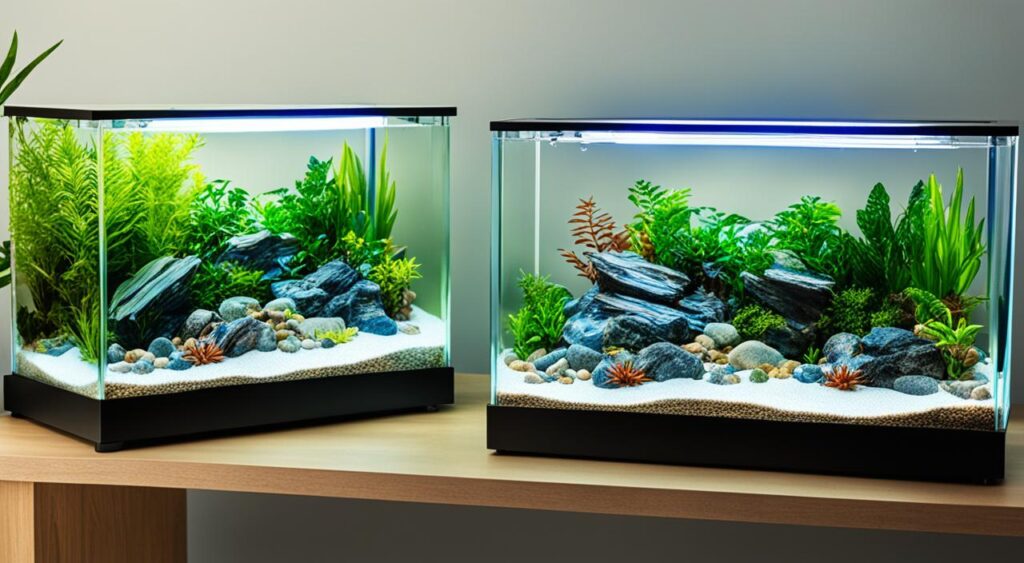
| Factors | Glass Tanks | Acrylic Tanks |
|---|---|---|
| Durability | High | Moderate |
| Clarity | Excellent | Good |
| Weight | Heavier | Lighter |
| Scratch Resistance | Less prone to scratching | More susceptible to scratching |
| Impact Resistance | Less impact-resistant | High impact-resistant |
| Insulation | Standard | Excellent |
Importance of Dimensions in Tank Selection
Consider your tank’s dimensions to create a thriving aquatic environment. The tank’s length, width, and height play a significant role in the overall health and well-being of your aquatic life. These dimensions determine the fish’s available swimming space and influence the decorations and equipment layout. Different fish species have varying spatial requirements, so choosing a tank size that suits their needs is essential.
Length, Width, and Height
The length of the tank is crucial as it provides a suitable distance for fish to swim and explore. Extended tanks are often preferred, allowing for more natural and unhindered movement. The width of the tank is crucial for providing ample space for fish to turn and maneuver. A more comprehensive tank allows for a more spacious environment and reduces stress on the fish. Lastly, the height of the tank is essential for accommodating certain fish species, especially those that prefer to swim vertically or require greater water depth.
Shape and Its Impact on Aquatic Life
The shape of the tank also impacts the aquatic life within it. Some fish species thrive better in tanks with specific shapes. For example, angelfish prefer taller tanks that mimic their natural habitat, while bettas prefer tanks with a smaller footprint. The shape of the tank can also affect water circulation and the behaviour of the fish. Choosing a tank shape that suits the needs of the fish species you intend to keep is vital.
| Tank Dimensions | Recommended Fish Species |
|---|---|
| Rectangular – Long | Tetras, Livebearers, Corydoras |
| Rectangular – Tall | Angelfish, Gouramis, Discus |
| Bowfront | Bettas, Neons, Rasboras |
| Cube | Dwarf Cichlids, Shrimp, Snails |
When selecting a tank, consider the dimensions best suit the fish species you plan to keep. A suitable environment miming their natural habitat will improve their health and well-being.
Considerations Beyond Material and Shape
When setting up a 20 gallon tank, important considerations go beyond the tank’s material and shape. These factors play a crucial role in creating a safe and thriving environment for aquatic life.
Weight and Placement
The tank’s weight is a critical factor to consider. The structure or surface on which the tank will be placed must adequately support its weight. A 20 gallon tank filled with water can be pretty heavy, so choosing a sturdy and stable location is crucial.
When considering the weight and placement of a 20-gallon aquarium, it’s crucial to understand the total weight once it’s filled with water, substrate, decorations, and living organisms.
Water alone weighs about 8.34 pounds per gallon, meaning a 20-gallon tank will hold approximately 167 pounds of water. Adding gravel or substrate, which can weigh around 1.5 to 2 pounds per gallon for a light layer (30-40 pounds total), along with decorations and equipment, can push the total weight to 200 pounds or more.
Therefore, choosing a robust stand designed to support the weight of a fully equipped aquarium is essential. Placement is equally important; the tank should be situated away from direct sunlight to prevent algae growth and temperature fluctuations and on a level surface to avoid undue stress on the tank structure.
For instance, a 20-gallon glass aquarium placed on a dedicated aquarium stand in a living room corner, away from windows and heavy traffic areas, can ensure stability, ease of maintenance, and enjoyable viewing.
Maintenance and Durability
Maintenance and durability are crucial factors when setting up your 20 gallon aquarium. Regular maintenance is necessary for keeping the water clean and healthy for your fish. It involves water changes, filter cleaning, and monitoring water parameters.
Choosing a tank with durable materials will ensure that it can withstand the test of time. Look for high-quality glass or acrylic tanks that won’t easily crack or chip. Consider the impact of any decorations or equipment you plan to add to the tank and choose compatible materials.
Creating an efficient and durable aquarium setup will reduce the need for frequent repairs or replacements, saving you time and money in the long run.
In summary, when setting up a 20 gallon tank, it is essential to consider its weight and placement, as well as its maintenance and durability. Ensuring proper weight distribution and stability will provide a safe environment for your aquatic life, while regular maintenance and durable materials will contribute to a long-lasting and efficient setup.
Making Your Decision: What Suits Your Needs?
Now that you’ve explored the various factors to consider when choosing a 20 gallon tank for your aquarium, it’s time to decide. Step back and assess your needs, preferences, and skill level. Consider the type of tank that would best suit your goals and the species of fish you want to keep.
Think about the tank’s material—whether you prefer the durability of glass or the lightweight nature of acrylic. Consider the dimensions that would provide the ideal swimming space for your fish and the layout that would allow for a visually appealing setup. Evaluate the tank’s placement to ensure it is in a suitable location with stable temperature and lighting conditions.
Explore custom aquarium options if you’re looking for a unique and visually stunning aquarium. These allow you to design a tank that fits your aesthetic preferences and creates a distinct focal point in your home or office. Consult our tank setup guide to ensure you have all the necessary equipment and processes for a successful aquarium journey.
Ultimately, the decision is yours to make. By considering all the factors and your needs and preferences, you can create a 20 gallon tank setup that provides a thriving environment for your aquatic pets and brings joy and beauty into your space.

